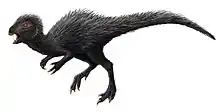Haya griva
Haya is an extinct genus of basal neornithischian dinosaur known from Mongolia.[1]
| Haya | |
|---|---|
 | |
| Life restoration of H. griva | |
| Scientific classification | |
| Kingdom: | Animalia |
| Phylum: | Chordata |
| Clade: | Dinosauria |
| Order: | †Ornithischia |
| Family: | †Parksosauridae |
| Genus: | †Haya Makovicky et al., 2011 |
| Species: | †H. griva |
| Binomial name | |
| †Haya griva Makovicky et al., 2011 | |
Description
Haya is known from several well-preserved specimens which collected in the Khugenetslavkant locality by the joint Mongolian Academy of Sciences from 2002 to 2007, from the Javkhlant Formation. The locality probably dates to the Santonian stage of the Late Cretaceous. The holotype IGM 100/2017 is composed of a complete and well preserved skull with some postcranial elements associated to it. Referred materials include IGM 100/1324, isolated left femur, IGM 100/2013, postcranial elements, IGM 100/2014, a crushed skull and postcranial elements, IGM 100/2015, a nearly complete postcranial skeleton, IGM 100/2016, a partial juvenile skull, IGM 100/2018, an isolated mandible with some teeth, IGM 100/2019, a nearly complete skull and skeleton and IGM 100/2020, postcranial fragments. One skeleton of Haya, IGM 100/2015, preserves a large mass of gastroliths.
Etymology
Haya was first named by Peter J. Makovicky, Brandon M. Kilbourne, Rudyard W. Sadleir and Mark A. Norell in 2011 and the type species is Haya griva. The generic name and the specific name are both derived from the Sanskrit for the "Hayagriva" avatar of the Hindu god Vishnu, depicted with a horse head. This name refers to the elongate horse-like skull of Haya and the appearance of this deity in the Buddhist art of Mongolia.[1]
Phylogeny
A cladistic analysis found it to form a clade with Jeholosaurus and Changchunsaurus within Ornithopoda.[1] Han et al. named this clade "Jeholosauridae" in 2012.[2]
The cladogram below results from analysis by Herne et al., 2019.[3]
| Ornithischia |
| ||||||||||||||||||||||||||||||||||||||||||||||||||||||||||||||||||||||||||||||||||||||||||||||||||||||||||||||||||||||||||||||||||||||||||||||||||||||||||||||||||||||||
References
- Makovicky, Peter J.; Brandon M. Kilbourne; Rudyard W. Sadleir; Mark A. Norell (2011). "A new basal ornithopod (Dinosauria, Ornithischia) from the Late Cretaceous of Mongolia". Journal of Vertebrate Paleontology. 31 (3): 626–640. doi:10.1080/02724634.2011.557114.
- Han, Feng-Lu; Paul M. Barrett; Richard J. Butler; Xing Xu (2012). "Postcranial anatomy of Jeholosaurus shangyuanensis (Dinosauria, Ornithischia) from the Lower Cretaceous Yixian Formation of China". Journal of Vertebrate Paleontology. 32 (6): 1370–1395. doi:10.1080/02724634.2012.694385.
- Herne, Matthew C.; Nair, Jay P.; Evans, Alistair R.; Tait, Alan M. (2019). "New small-bodied ornithopods (Dinosauria, Neornithischia) from the Early Cretaceous Wonthaggi Formation (Strzelecki Group) of the Australian-Antarctic rift system, with revision of Qantassaurus intrepidus Rich and Vickers-Rich, 1999". Journal of Paleontology. doi:10.1017/jpa.2018.95.
